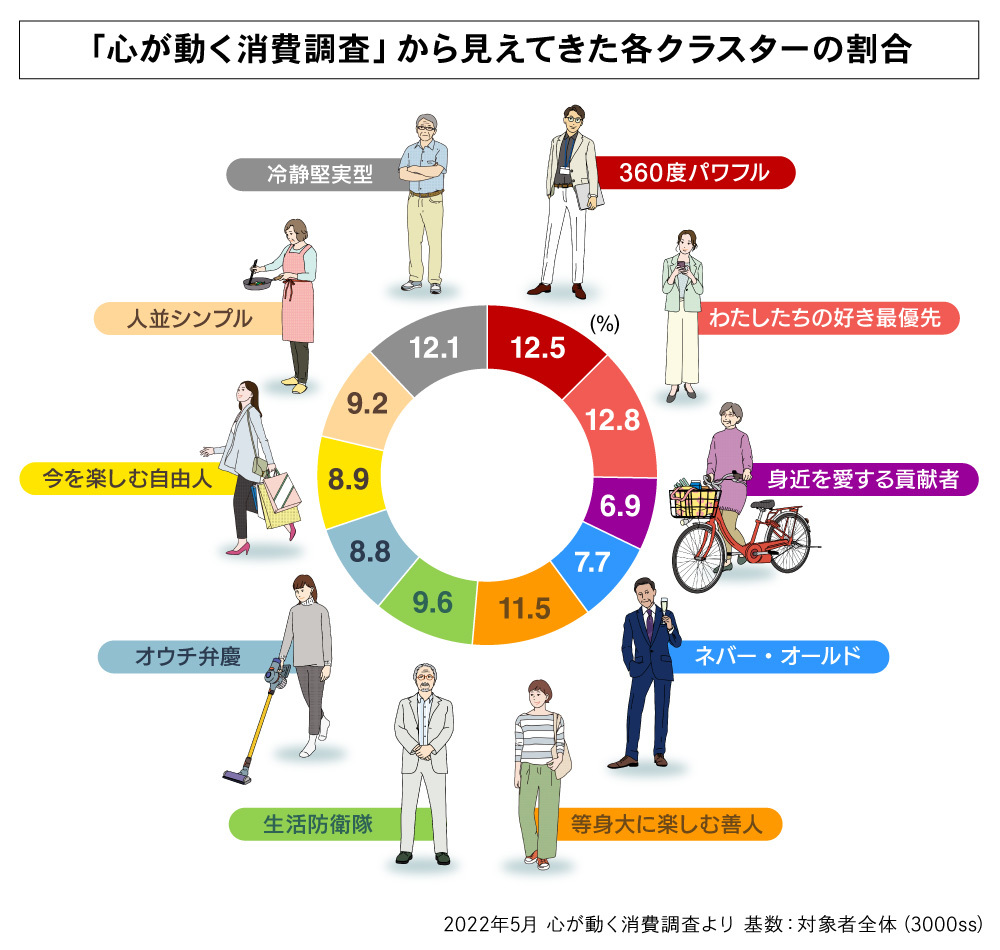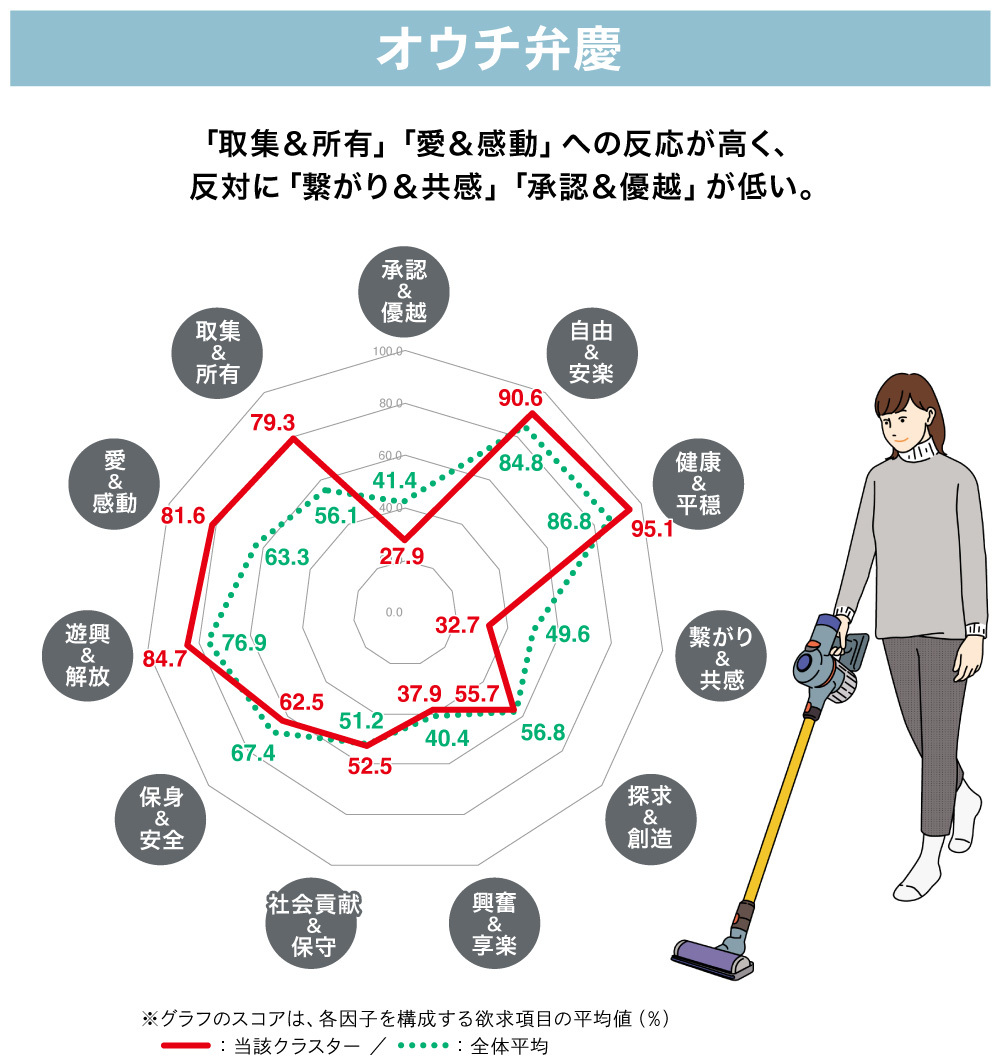DENTSU DESIRE DESIGN (DDD) is a project that seeks to unravel the modern consumer profile, increasingly elusive to companies, by revisiting consumption consciousness rooted in "Desire."
In this series, DDD members will introduce their approach to consumer insights rooted in "desire" and future developments.
Last time, we introduced the results of a cluster analysis based on desire, showing the broad types of people with different desires that exist in the world. This time, we will focus on one of those clusters and explore how to approach desire to drive consumption that results from emotional engagement.
Three Essential Processes for Applying "Desire" to Marketing
At DDD, we classified desires into 10 distinct clusters based on scores derived from research across 11 desire factors (details here ).
This time, we focus on and unravel the " Home-Centered " cluster. The chart below shows the Home-Centered cluster's responses to the 11 desire factors. (For details on the 11 desires, see here ).
DDD considers marketing strategies to approach desires and drive actual consumption through three processes.
For each of these three steps, we introduce effective strategies for Ouchi Benkei.
〈1st STEP〉 Identify the Desire to Approach
First, identify which of the 11 desires held by Ouchi Benkei to approach. For Ouchi Benkei, the average response to desires classified under [Love & Emotion] and [Collecting & Possession] is higher than the overall average.
This means that for Ouchi Benkei, the desire to "love and be loved" is crucial—that is, experiences that provide a tangible sense of loving and being loved, and that evoke emotion, are important. For example, satisfaction from enriching one's surroundings or being surrounded by favorite things becomes a key point for an approach centered on desire.
〈2ndSTEP〉Define Customer Value Based on Desire

Once you've decided which desire to target, define how to provide value for that desire.
- Social Value
- Emotional Value
- Functional Value
Social Value
Social value refers to the perspective of whether your consumption activities contribute positively to society. Emotional value refers to the heightened feelings you gain from shopping. Functional value indicates the benefits you gain from the quality and functionality of that product or service.
How do the desires for [Love & Inspiration] and [Collection & Ownership], which showed high resonance among Ouchi Benkei, break down into these three elements? Let's examine this using concrete examples of emotionally resonant consumption actually reported by the Ouchi Benkei cluster in our May 2022 survey (details here ).
What are the social value, emotional value, and functional value that align with the desires for 【Love & Emotion】 and 【Collection & Possession】?
For [Love & Emotion]
For social value, it's crucial to feel that one's actions contribute to making society better. Specific comments from the survey include, for example, regarding " cat cafes ": "I want to heal my heart by interacting with cats. I want to donate to cat rescue activities and help the cats."
Emotional value relates to experiences that deeply move the heart. Examples include tear-inducing activities (ruikatsu) that relieve stress by making people cry.
A respondent who cited the film " The Elephant Man" shared: "The content was poignant and sad; I was deeply moved by the story. The pacing was excellent, and I think it's a wonderful film. It also offers life lessons."
Functional value involves emotionally moving experiences that appeal to the senses. A respondent who cited the book " Beautiful Libraries of the World " as an emotionally driven purchase stated, "I wanted to be moved by seeing images of beautiful libraries around the world." They further expressed a desire to be soothed by knowing such wonderful places exist and to reflect on various things beyond mere beauty by reading the stories about the libraries.
【Collection & Ownership】
The concepts of "Social Value," "Emotional Value," and "Functional Value" here are the same as in 【Love & Inspiration】.
For social value, " eco-bags " were cited. The respondent found benefits for both themselves and society, noting, "They were inexpensive, looked durable, and shipping was free. I thought changing eco-bags to match my mood would be a nice way to refresh my feelings."
For emotional value, " Evan Williams 12 Year " (whiskey) was cited as something that increases self-satisfaction when collected. The reason given—"I wanted to add it to my whiskey collection. Purely for the desire to own it"—revealed a simple collecting urge as the value.
For functional value, one answer was " commercial-grade plate udon noodles." The reason given was "I wanted to expand my repertoire of easy-to-make holiday meals." This shows an action driven by ownership: using it as a starting point to broaden the range of dishes one can cook.
〈3rdSTEP〉Applying the Desired Value and Its Three Value Elements to Marketing Initiatives
As the final step, we define the value proposition for the target cluster (in this case, Ouchi Benkei) and specify how the three value elements will be concretely delivered.
Products and services vary vastly by company and category. While there's no single definitive application to marketing strategies, this method is considered effective for devising initiatives that embody "consumption driven by emotional engagement resulting from addressing desires."
Specifically, for Ouchi Benkei—our focus here—we develop marketing ideas: how our products/services can deliver value, how to capture interest, and how to stimulate the desire to engage.
Given that the Ouchi Benkei we examined here exhibit strong desires for "Love & Emotion" and "Collecting & Ownership," marketing strategies that make contributions to society and the environment visible, thereby stimulating the urge to collect, would be an effective approach.
For example, an eco-bag featuring designs of their favorite things or hobbies would likely stimulate their collecting urge. Furthermore, by creating a DX system that visualizes their contribution to society and the environment based on how they use the bag, the Ouchi Benkei might just turn their attention to your company.
The growing urgency to solve energy and microplastic problems further supports this approach. Thus, providing products that satisfy their desire to both enjoy collecting favorite eco-bags and contribute to society becomes a key strategy for winning over the Home-bound Benkei.
While we explored this with the Homebody cluster, other clusters each possess unique desire patterns. The points that move their hearts toward consumption—their "pressure points"—differ for each desire cluster. Given the wide variety of products and services, there is no single correct answer.
The Dentsu Inc. Desire Design project will continue to tackle these diverse marketing challenges. Interested parties are welcome to contact us below.
【Contact Information】
DENTSU DESIRE DESIGN (Dentsu Inc. Design)
ddd-project@dentsu.co.jp
【Survey Overview】
Title: Dentsu Inc. "Heart-Moving Consumption Survey"
Survey Purpose: To analyze consumer consciousness, which is becoming increasingly difficult to visualize due to the ever-changing social environment, from the perspective of consumer desire, and to decipher the future of Japan's consumer society.
Target Area: Nationwide, Japan
Respondent Criteria: Ages 20–74
Sample Size: 3,000 samples (allocated according to population ratios across 6 age groups [20s-70s] and 2 gender categories)
Survey Method: Internet survey
Survey Period: May 2022 Survey; Thursday, May 12, 2022 – Sunday, May 15, 2022
Research Agency: Dentsu Macromill Insight, Inc.












